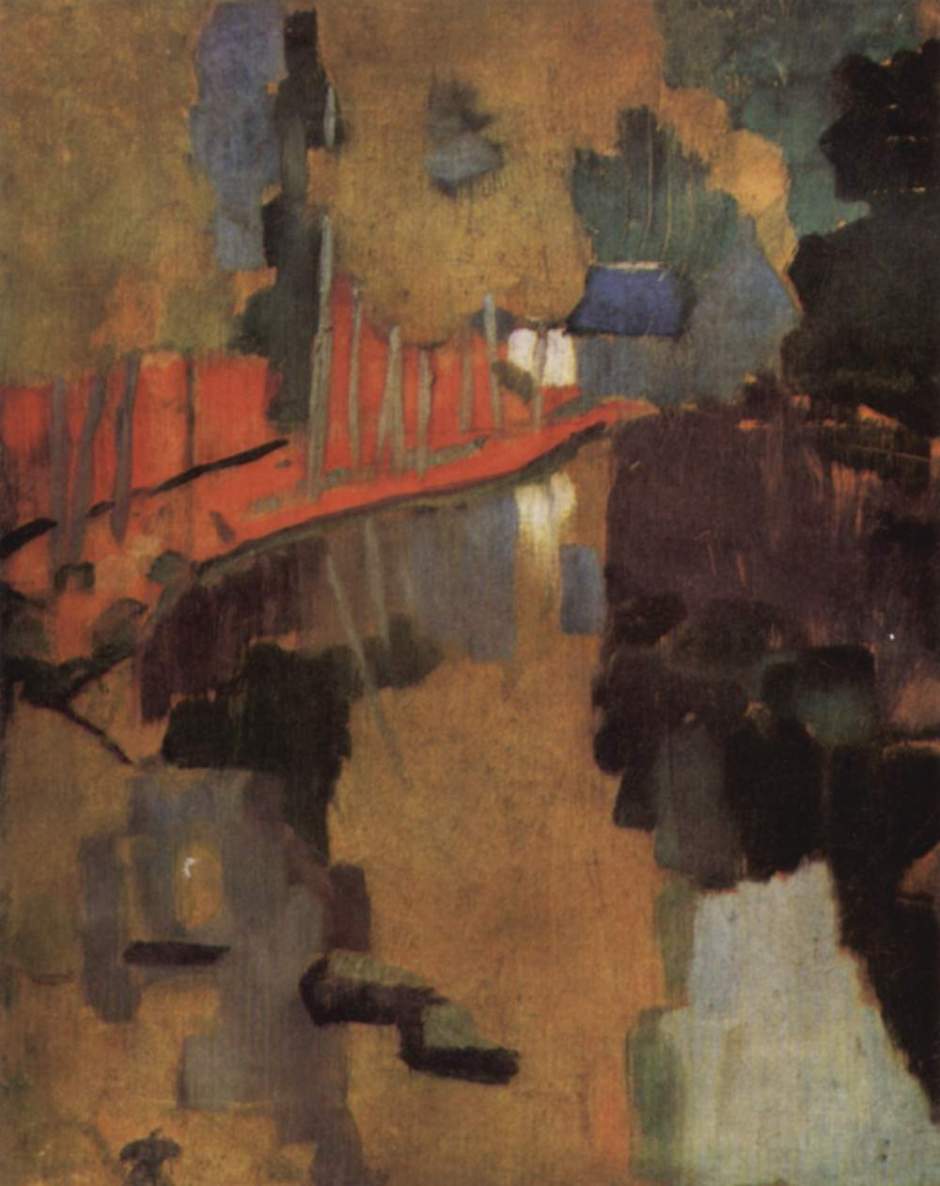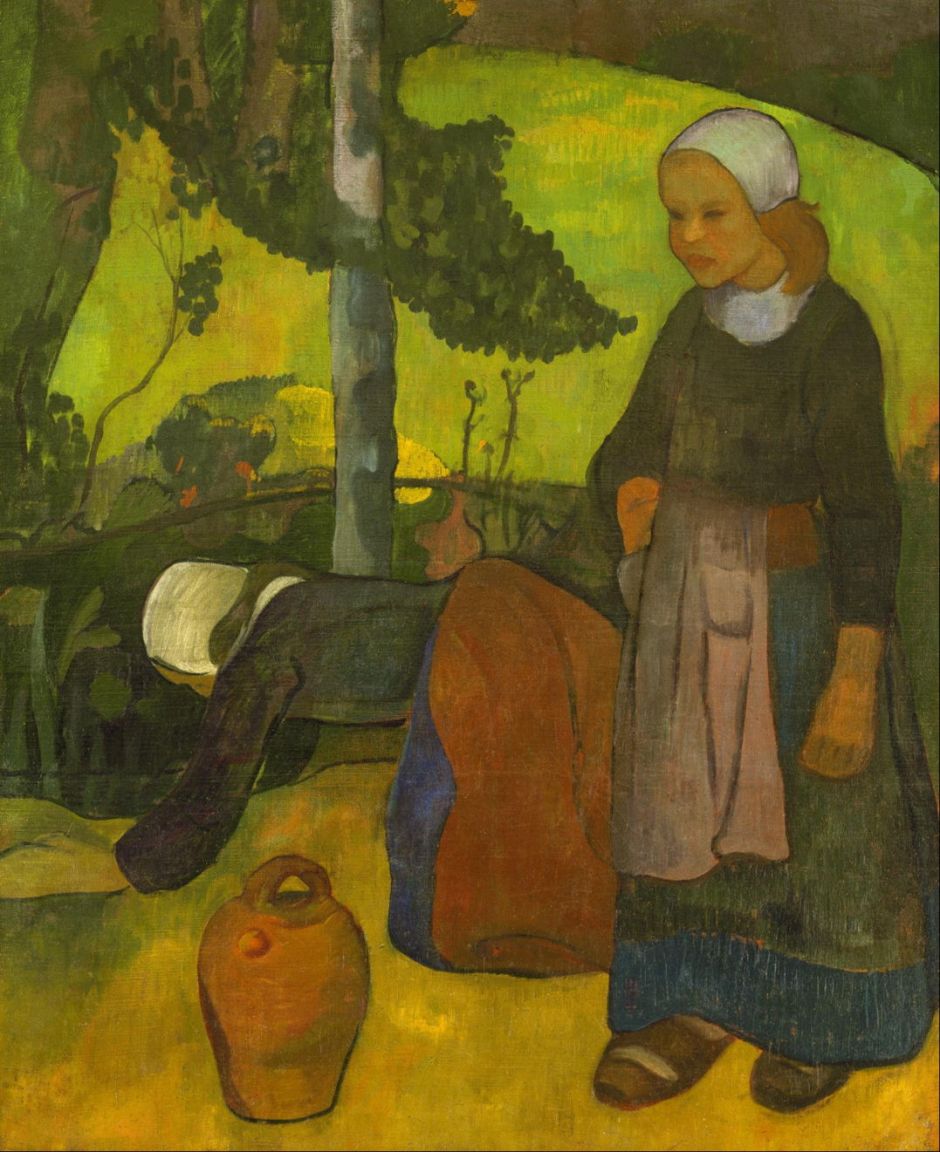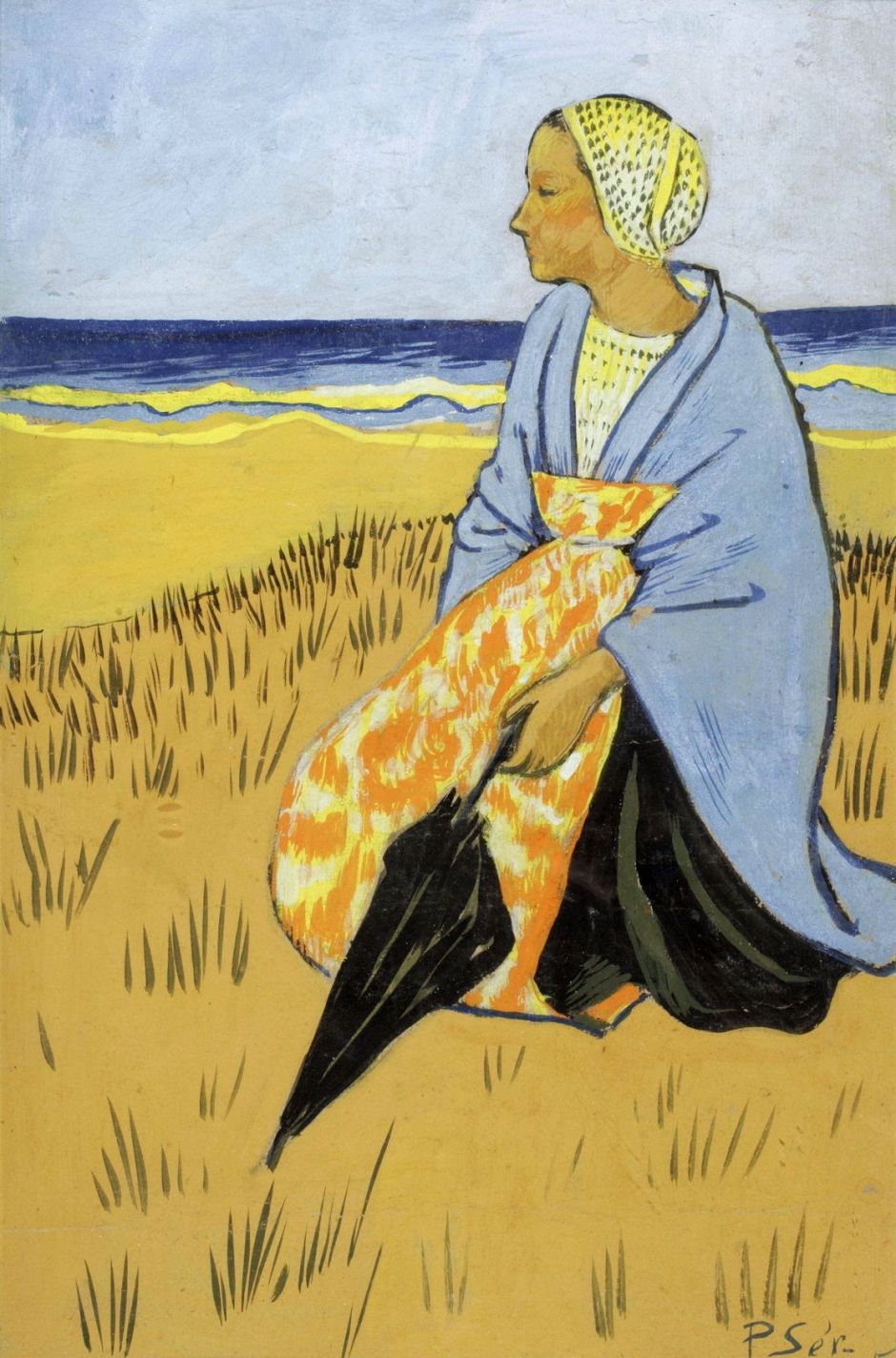Paul Sérusier: 1 The Talisman

One of the Nabis who seems to be remembered for but a single painting is Paul Sérusier (1864–1927), who is also claimed to be a “pioneer of abstract art”. He was certainly unusual among the Nabis for his style, which was closer to that of Gauguin than the rest of the group. In this and the next article I will try to discover more about his paintings.
Sérusier was born and studied in Paris. In the middle of the 1880s, he attended the Académie Julian, where the Nabis were starting to form as a movement. But unlike the others, in 1888 he left the city and went to live and work in the artists’ colony at Pont-Aven in Brittany. There he met and befriended Paul Gauguin, who had not long returned from his visit to Martinique; later in 1888, Gaugin stayed with Vincent van Gogh in Arles.
Paul Sérusier (1864–1927), The Weaver (1888), oil on canvas, 72 × 58 cm, Musée d’Art et d’Archéologie, Senlis, France. Wikimedia Commons.
Early in 1888, Sérusier painted The Weaver, a fine realist portrait of a weaver at work on his loom, looking into the light.
 Paul Sérusier (1864–1927), The Talisman (Landscape with Le Bois d’Amour in Pont-Aven) (1888), oil on canvas, 27 × 21.5 cm, Private collection. Wikimedia Commons.
Paul Sérusier (1864–1927), The Talisman (Landscape with Le Bois d’Amour in Pont-Aven) (1888), oil on canvas, 27 × 21.5 cm, Private collection. Wikimedia Commons.
Shortly after that, Sérusier painted his most famous work, The Talisman (also 1888) at Pont-Aven, under the close supervision of Gauguin. This was explained as being a ‘landscape with Le Bois d’Amour in Pont-Aven’, but it is now widely considered to be a radical move towards abstract art. Sérusier returned to Brittany in the summers of 1889 and 1890, and local motifs dominated his art until the early 1890s.
It was the Nabis who gave this painting its name, adopting it as a sort of religious icon. Despite that, it stands unique among their art for its unusual treatment of a landscape and doesn’t appear to have been used by them as a model for other paintings.
 Paul Sérusier (1864–1927), Landscape at Le Pouldu (1890), oil on canvas, 74.3 x 92.1 cm, Museum of Fine Arts, Houston, TX. Wikimedia Commons.
Paul Sérusier (1864–1927), Landscape at Le Pouldu (1890), oil on canvas, 74.3 x 92.1 cm, Museum of Fine Arts, Houston, TX. Wikimedia Commons.
Sérusier’s later paintings in Brittany were far less radical, and show different post-Impressionist influences. His Landscape at Le Pouldu from 1890 experiments with Cézanne’s constructive strokes, which are most prominent in the foliage of the trees.
 Paul Sérusier (1864–1927), Seaweed Gatherer (c 1890), oil on canvas, dimensions not known, Indianapolis Museum of Art, Indianapolis, IN. Wikimedia Commons.
Paul Sérusier (1864–1927), Seaweed Gatherer (c 1890), oil on canvas, dimensions not known, Indianapolis Museum of Art, Indianapolis, IN. Wikimedia Commons.
His Seaweed Gatherer from about 1890 again uses constructive strokes to build the geometric forms of haystacks and fields. A lone man is bent double behind a low stone wall, apparently gathering seaweed, which is strangely concealed from view.
 Paul Sérusier (1864–1927), Washerwomen (1886/1897), oil on canvas, 89.9 x 73.7 cm, Museum of Fine Arts, Houston, TX. Wikimedia Commons.
Paul Sérusier (1864–1927), Washerwomen (1886/1897), oil on canvas, 89.9 x 73.7 cm, Museum of Fine Arts, Houston, TX. Wikimedia Commons.
Sérusier apparently started work on Washerwomen while still at the Académie Julian in 1886, but is thought to have completed it as late as 1897. Its style is strongly influenced by Gauguin’s work during his visits to Pont-Aven, and there is little evidence of his early realism or of constructive strokes, suggesting that a date of around 1888-90 is more probable.
From about 1890, Sérusier became more integrated with the Nabis, often meeting and working in the Paris studio shared by Pierre Bonnard, Édouard Vuillard and Maurice Denis. He was dubbed le nabi à la barbe rutilante, ‘the Nabi with the shiny beard’.
 Paul Sérusier (1864–1927), Portrait of Paul Ranson in Nabi costume (1890), oil on canvas, 60 x 40 cm, Musée d’Orsay, Paris. Wikimedia Commons.
Paul Sérusier (1864–1927), Portrait of Paul Ranson in Nabi costume (1890), oil on canvas, 60 x 40 cm, Musée d’Orsay, Paris. Wikimedia Commons.
In 1890, Sérusier painting this humorous Portrait of Paul Ranson in Nabi Costume. Adopting almost mediaeval style, Ranson, known for his religious paintings, is cast in the role of a bishop clutching an ornate crosier and reading from an illuminated book.
 Paul Sérusier (1864–1927), Breton Wrestling (1890-91), oil on canvas, 92 x 73 cm, Musée d’Orsay, Paris. Wikimedia Commons.
Paul Sérusier (1864–1927), Breton Wrestling (1890-91), oil on canvas, 92 x 73 cm, Musée d’Orsay, Paris. Wikimedia Commons.
I hadn’t realised that wrestling was a local sport in Brittany, where it’s known as gouren, but in 1890-91, Sérusier showed a bout taking place in his painting of Breton Wrestling. This almost died out after the First World War, but was revived in the 1930s and is currently flourishing there.
In 1892, Sérusier joined Maurice Denis and other Nabis in designing sets for a theatrical production of Rimbaud’s Bateau Ivre.
 Paul Sérusier (1864–1927), Portrait of Emile Bernard in Florence (1893), tempera on canvas, 73 x 56.5 cm, location not known. Wikimedia Commons.
Paul Sérusier (1864–1927), Portrait of Emile Bernard in Florence (1893), tempera on canvas, 73 x 56.5 cm, location not known. Wikimedia Commons.
Although still one of the Nabis, Sérusier remained close friends with artists with whom he had worked in Pont-Aven, largely followers of Gauguin. Among them was Émile Bernard (1868-1941), who by 1893 had allied himself with Symbolists such as Odilon Redon, and travelled to Italy and the Middle East. I presume that Sérusier must have accompanied him at least as far as Florence, to paint this Portrait of Emile Bernard in Florence (1893).
This work also marks a period in which Sérusier experimented with painting in tempera on canvas, presumably to return to pre-Renaissance style, something reflected here in his Giotto-like perspective. However, he doesn’t appear to have adopted original tempera technique as well. The bridge shown is the Ponte Vecchio, and the prominent dome is that of the Duomo by Brunelleschi, who was the pioneer of modern linear perspective.
 Paul Sérusier (1864–1927), The Snake Eaters (1894), tempera on canvas, 127 x 161 cm, Muzeum Narodowe w Warszawie, Warsaw, Poland. Wikimedia Commons.
Paul Sérusier (1864–1927), The Snake Eaters (1894), tempera on canvas, 127 x 161 cm, Muzeum Narodowe w Warszawie, Warsaw, Poland. Wikimedia Commons.
The Snake Eaters from 1894, another work in tempera on canvas, is one of Sérusier’s most puzzling paintings. It seems to show a cultic religious ceremony taking place in the woods of Brittany, but apparently refers to the writings of Gabriela Zapolska, a naturalist Polish author who lived in Paris from 1889, and may have been in the same artistic circles.
 Paul Sérusier (1864–1927), The White Cow (c 1895), tempera on canvas, 60 x 73 cm, Muzeum Narodowe w Warszawie, Warsaw, Poland. Wikimedia Commons.
Paul Sérusier (1864–1927), The White Cow (c 1895), tempera on canvas, 60 x 73 cm, Muzeum Narodowe w Warszawie, Warsaw, Poland. Wikimedia Commons.
The last of Sérusier’s tempera works appear to have been made in the mid 1890s, at about the time that he used that medium to paint The White Cow (c 1895). The cloud-like blossom on the tree and textured grass are quite unlike his earlier use of constructive strokes.
 Paul Sérusier (1864–1927), Breton Woman Sitting on the Seashore (1895), indian ink and gouache on paper, 45.5 x 29 cm, Muzeum Narodowe w Warszawie, Warsaw, Poland. Wikimedia Commons.
Paul Sérusier (1864–1927), Breton Woman Sitting on the Seashore (1895), indian ink and gouache on paper, 45.5 x 29 cm, Muzeum Narodowe w Warszawie, Warsaw, Poland. Wikimedia Commons.
Probably from the same year is this ink and gouache painting of a Breton Woman Sitting on the Seashore (1895), in the style of Gauguin.
